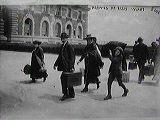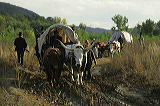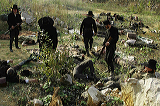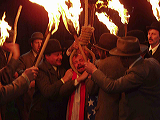
with support from the EU MEDIA program and the Filmstiftung NRW
The year is 1853, two days before Easter Sunday in a small village in the Westerwald region of southwestern Germany. On the village square there’s quite a tumult. Beds, cabinets, dressers, animals, and carts are being auctioned off to the highest bidder. A whole village is going to emigrate. The place of their hopes and dreams: America.
In a four-part television series, “Germans in America” recounts the story of German immigrants to the United State, using gripping stories about naive settlers and successful farmers, about devout free-thinkers and political refugees, about the heyday of the German-language press in America, and about the founders of industrial dynasties in the new homeland.
60 Million Americans have their origins in German-speaking countries. As America’s largest ethnic group, the Germans made a significant mark on America’s cultural, business, and public life for centuries until their identity fell victim to feelings of shame and repression during and after two World Wars. But their achievements are still the basis for much of American culture.
Location shooting, archival footage, the descendants of immigrants, and carefully done historical recreation bring German-American history to life.

Press photos
Summer 2003: a group of 40 German-Americans from Loose Creek, Missouri travel to Germany. They are on a search for their roots and will find them in a farm in the Rhineland. One-hundred-fifty years ago, the Münks farm was the birthplace of their ancestors.
For German emigrants in the 19th century, America offered hope in a new beginning: the hope of escaping poverty, years of failed harvests, and political repression. Thanks to romanticized ideas, millions of Germans start off for the unknown. It is the great century of emigration—and for agents, shipping companies, and captains it was a great business opportunity.
Enthusiastic letters from relatives and friends in the new world attract hundreds of thousands of others to follow them. Among these people are Jacob Münks and his family from Lank, near Düsseldorf. They want to move to America’s Midwest, to the so-called “German Belt.” Together with his wife and his six children, Münks survived the difficult sea passage on a cargo ship that was turned temporarily into a passenger vessel.
The film follows the family’s journey by way of St. Louis to Loose Creek in Missouri. Nearby, in Hermann, Missouri, Westphalians have settled. Washington, Missouri is home to people from the German Palatinate. And Loose Creek is for the Rhinelanders. The German settlers seek out people from their own home regions and avoid settling in the open countryside. But the pioneer years are hard on the Münks. The farm will not yield enough for them to live on. So Gerhard Münks travels to St. Louis and decides to wander off to California. Gold fever has reached in the far reaches of the Midwest. For three years he was thought to be dead. Until he appears one day looking like a tramp, but carrying home riches from the gold fields following an adventurous trip. Still today, the family has his gold scales and a nugget he brought home. The farm remains today in the same family’s possession.

PROGRAM TWO: THE PRICE OF FREEDOM
Press photos
The year is 1862. A group of 65 young men are fleeing across the Texas prairie. These sons of German-American farmers are desperately trying to break through to the North to fight for the Union army. Suddenly, they run into trouble in the form of Confederate troops. Their riverside camp is surrounded and half the party is summarily executed. The rest are tracked down on the prairie; only a few make it across the Mexican border to safety.
Two decades earlier their families, full of hope, had crossed the Atlantic to Galveston. Back in the German principalities, aristocrats and speculators had been touting a plan for massive settlement in Texas. Thousands left, only to find that neither transportation nor land awaited them. It was a gigantic swindle. Nevertheless the immigrants set out toward Austin on a trek that soon became a death march. Four thousand, about half their number, died of hunger, thirst and sickness.
The The Mainz “Committee of Nobles” (The „Mainzer Adelsverein“) has had the ambitious idea of founding a German colony in Texas. The nobles are convinced that their plan makes good business sense. At the same time, they hope to be rid of the increasing number of malcontents in the country. Prince von Solms becomes their agent in Texas and naively agrees to acquire lands for the new colony some 300 miles inland. Lands that he’s never set eyes on. Lands that are completely inaccessible and that are the hunting grounds of the much feared Comanches.
In 1846 the first settlers arrive in Texas after a strenuous and stressful ocean voyage. The wagons needed to carry them inland are not available. The settlers build temporary camps in the swamps and are dependent on the Committee of Nobles for supplies and food. Hundreds become ill with yellow fever. The desperate Prince Solms acquires 1,300 acres of good land on the Guadelupe River, situated halfway between the coast and the lands that the Committee had purchased before. New Braunfels is founded in this spot. But time is of the essence as even more ships have set sail from Germany with would-be colonists. The designated settlers start off on the hard journey in a few oxcarts.
Today the descendants of those survivors, the distant relatives of those young men, live on in the hill country beyond Austin. And there, still today, their culture and language continue to thrive in the lively festivals of New Braunfels and Fredericksburg.
Until recently a German-language newspaper continued to be printed here. A German society keeps up the contact with the old country. And each year there’s a Peace Treaty Pow-wow where the treaty between the Germans and the Comanches is honored and celebrated. The only treaty with Native Americans that has never been broken.

Press photos
June 15, 1904, screams fill the air over the East River. The screaming of people who are drowning. The “General Slocum,” an excursion boat, is on its way to Long Island. On board are mostly families from New York’s Little Germany. Over one thousand German-Americans die in the river on this early summer’s day. From drowning, burning, or caught up in the boat’s paddle-wheels. The catastrophe marks the end of this Little Germany, a neighborhood in New York’s Lower East Side.
“Little Germanies” are blooming all over the United States in the second half of the 19th century. Businesses and cultural institutions, schools and churches, newspapers and clubs—everything is there for the powerful and rich German-speaking communities. In New York’s Little Germany, there are more than 70,000 Germans in the second half of the 19th century. Castle Garden and thenEllis Island are the central points of immigration. The newcomers are overwhelmingly working-class people without substantial wealth. They live and eat cheaply, work hard, and economize in everything. Many immigrants bring a small bag of dirt with them. They plan to be buried with this little handful of the old country, since generally there’s no way to go back home again.
The program follows the stories of two immigrant families.
First, the Steinwegs, who found Steinway & Sons three years after their arrival and settle in und Manhattan. All the children work in the family business. They develop the Steinway grand piano, obtain many patents, and their instruments earn a world-wide reputation. In 1865, the business moves to Queens—where it’s still located today.
At the other end of the spectrum is the Gumpertz family, which struggles to find a way out of the slums of New York’s Little Germany. Overcrowded apartments without sanitary facilities are breeding places for tuberculosis, typhus, and cholera. One-third of the children die before they learn to walk. On October 17, 1874, Nathalie Gumpertz waits in vain for her husband to come home. Julius never returns. In those hard times, many men committed suicide or simply disappear, because they can’t stand the misery that their families are living in.
For one of these families, the American dream becomes reality; for the other it’s a test of life and death.

Press photos
Germany 1937: Sixteen-year-old Max Ebel, a known Anti-Fascist, is threatened by Hitler Youths. He is wounded with a knife. Staying in Germany is becoming life-threatening for him. So he decides to flee to Boston, where his father is living.
By the early twentieth century, the German-Americans have become one of the the country’s most important ethnic groups in business, finance, education, research, and agriculture. But they look back across the Atlantic with great concern. In Europe a horrible war has broken out. Anti-German propaganda heats the country up for war and brings out intolerance and hate. These were the patterns that German-Americans had to deal with during the First World War. Everything German is struck from the American language. German family names are americanized. German culture disappears from public life. During both world wars, German-Americans try to keep any German identity under wraps. Many are suspected of being spies. A harmless workman of German ancestry named Robert Prager is lynched by nationalistic Americans.
Freshly arrived in America, Max Ebel volunteers for the military. He asks to serve in the Pacific theater and asks that he not be sent to war in Germany, since his brother and his mother are still living there. This is to be his undoing. Max Ebel is arrested and imprisoned for many months in various internment camps.
Masses of people flee the Nazi terror and the USA sets stricter immigrant quotas than ever before in its history. This is the atmosphere in which the Nathorffs, an esteemed Jewish-German couple, both medical doctors from Berlin, find themselves also when they flee Germany. Almost penniless, Hertha Nathorff, once the celebrated director of the Red Cross Children’s Hospital in Berlin, describes the drama of her exile in her deeply moving diary. She earns money in New York as a cleaning lady and as a piano-player in a bar in order to pay for her husband’s American medical training, but she’s not allowed to work as a physician herself. Hertha Nathorff dies in the 1990s in New York, impoverished and embittered.
After the war was over, it took decades to re-build a relationship between German-Americans and Germans. Nowadays, the old German immigrants have been completely absorbed into the American “melting pot.” Even Max Ebel is still living today in New Hampshire.